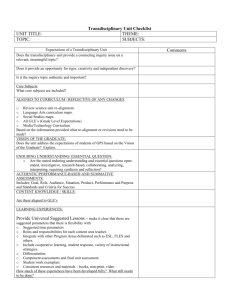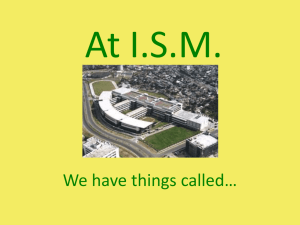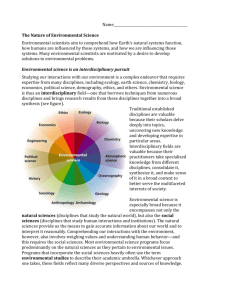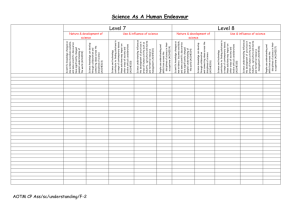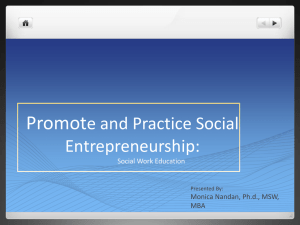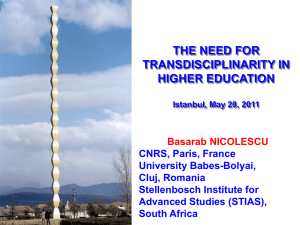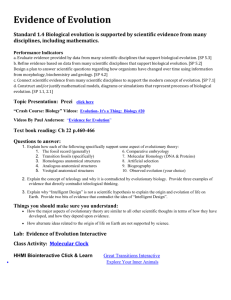4. Towards a Transdisciplinary Research and Education Agenda
advertisement
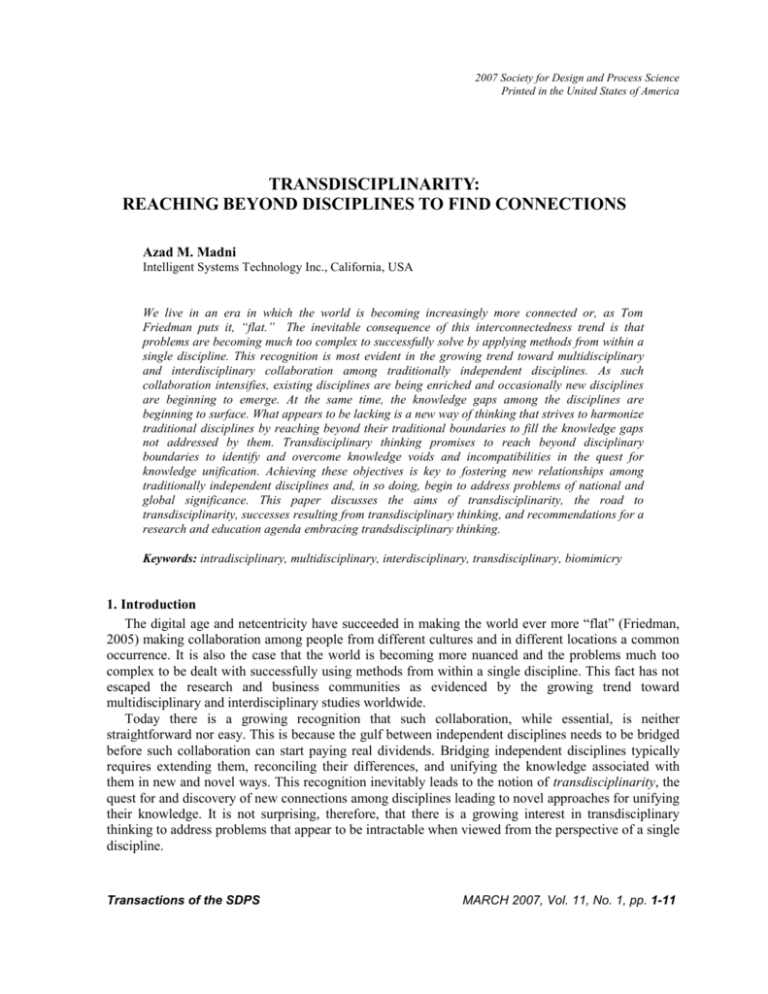
2007 Society for Design and Process Science Printed in the United States of America TRANSDISCIPLINARITY: REACHING BEYOND DISCIPLINES TO FIND CONNECTIONS Azad M. Madni Intelligent Systems Technology Inc., California, USA We live in an era in which the world is becoming increasingly more connected or, as Tom Friedman puts it, “flat.” The inevitable consequence of this interconnectedness trend is that problems are becoming much too complex to successfully solve by applying methods from within a single discipline. This recognition is most evident in the growing trend toward multidisciplinary and interdisciplinary collaboration among traditionally independent disciplines. As such collaboration intensifies, existing disciplines are being enriched and occasionally new disciplines are beginning to emerge. At the same time, the knowledge gaps among the disciplines are beginning to surface. What appears to be lacking is a new way of thinking that strives to harmonize traditional disciplines by reaching beyond their traditional boundaries to fill the knowledge gaps not addressed by them. Transdisciplinary thinking promises to reach beyond disciplinary boundaries to identify and overcome knowledge voids and incompatibilities in the quest for knowledge unification. Achieving these objectives is key to fostering new relationships among traditionally independent disciplines and, in so doing, begin to address problems of national and global significance. This paper discusses the aims of transdisciplinarity, the road to transdisciplinarity, successes resulting from transdisciplinary thinking, and recommendations for a research and education agenda embracing trandsdisciplinary thinking. Keywords: intradisciplinary, multidisciplinary, interdisciplinary, transdisciplinary, biomimicry 1. Introduction The digital age and netcentricity have succeeded in making the world ever more “flat” (Friedman, 2005) making collaboration among people from different cultures and in different locations a common occurrence. It is also the case that the world is becoming more nuanced and the problems much too complex to be dealt with successfully using methods from within a single discipline. This fact has not escaped the research and business communities as evidenced by the growing trend toward multidisciplinary and interdisciplinary studies worldwide. Today there is a growing recognition that such collaboration, while essential, is neither straightforward nor easy. This is because the gulf between independent disciplines needs to be bridged before such collaboration can start paying real dividends. Bridging independent disciplines typically requires extending them, reconciling their differences, and unifying the knowledge associated with them in new and novel ways. This recognition inevitably leads to the notion of transdisciplinarity, the quest for and discovery of new connections among disciplines leading to novel approaches for unifying their knowledge. It is not surprising, therefore, that there is a growing interest in transdisciplinary thinking to address problems that appear to be intractable when viewed from the perspective of a single discipline. Transactions of the SDPS MARCH 2007, Vol. 11, No. 1, pp. 1-11 Transdisciplinarity is a global perception of the ultimate connection of multiple (possibly all) disciplines (Nicolescu, 1997). From this perspective, not only science, but all human activities appear as a unitary whole, and part of the unity of the universe. According to Rodriguez Delgado, an eminent Spaniard systemist, unity and diversity (within transdisciplinarity) are not viewed as opposing, but complementary perspectives. Despite its obvious allure, transdisciplinarity faces many challenges. To begin with, there is no single, agreed upon definition of transdisciplinarity. In particular, academic and societal viewpoints differ. This lack of a common definition is further exacerbated with the formation of new societies, each promoting their own language for discourse. Fortunately, the academic and business communities remain undaunted as evidenced by the growing interest worldwide in infusing transdisciplinary concepts and projects into their educational and research agendas. For example, when it comes to public health, the National Academies (National Academies, 2002) recommends moving from research dominated by a single discipline or a small number of disciplines to transdisciplinary research. They define transdisciplinary research as involving broadly constituted teams of researchers that work across disciplines to develop significant research questions. In these recommendations, transdisciplinary research implies the conception of research questions that transcend individual disciplines and specialized knowledge bases because they are intended to solve applied public health research questions that are, by definition, beyond the purview of any single discipline. In transdisciplinary research, different specialties combine their expertise (and that of community members) to collectively define the health problem and their solutions. The National Academies sum up their position by pointing out that the one qualitatively different and unique aspect of the transdisciplinary process is the holistic blending of expert and community inputs to produce greater integration across disciplines. Transdisciplinary research (Fairclough, 2003, Fairclough 2005) implies a dialogue between the different disciplines and theories with a view to advancing both methodological and theoretical developments. This characteristic sets transdisciplinary research apart from some forms of interdisciplinary research which tend to “assemble” different disciplines around particular themes and projects without a commitment to changing the boundaries and relations between them. In light of the foregoing, it is worth clarifying the differences among intradisciplinary, multidisciplinary, interdisciplinary, and transdisciplinary research. Intradisciplinary research involves problems that can be successfully tackled from within a single discipline such as engineering or medicine. Multidisciplinary research involves problems that require cooperation among individuals from different disciplines. Interdisciplinary research involves cooperation among disciplines leading to enrichment of one or more contributing disciplines and occasionally resulting in new discipline. Transdisciplinary research involves looking beyond traditional disciplines to find new connections among disciplines that facilitate knowledge unification. Table 1 compares and contrasts these various forms of research initiatives. It is worth recognizing that transdisciplinarity originates from the increasing demand for relevance and applicability of academic research to societal challenges (Nicolescu, 2002). Not surprisingly, the two popular definitions of transdisciplinary research today center around academic research and societal challenges. The academic research-oriented definition characterizes transdisciplinarity as “a special form of interdisciplinarity in which boundaries between and beyond disciplines are transcended and disciplines as well as non-scientific sources are integrated.” The societal challengeoriented definition characterizes transdisciplinarity as “a new form of learning and problem-solving involving cooperation among different parts of society (including academia) to meet complex societal challenges. Solutions devised are a result of collaboration and mutual learning among multiple stakeholders.” As can be seen from the preceding two definitions, there is no standard definition of transdisciplinarity. What is common to both, however, is the unity of knowledge. Journal of Integrated Design and Process Science MARCH 2007, Vol. 11, No. 1, pp. 2 Table 1. Research typology Research Types Comparison Factors Scope Focus Key Characteristics Intradisciplinary Multidisciplinary Collaboration among individuals within a discipline One branch of specialization within the research field (e.g., quantum physics within physics) Generally, study the same “research objects,” but not always (e.g., multiple branches of modern physics) Tend to have methodologies in common Tight communications Mostly speak a common language Add to the BOK of a branch/ discipline Collaboration among individuals from different disciplines Complex problem management and incompatibility resolution through collaboration Harmonize multiple, occasionally contradictory/ incompatible aspects Integration between disciplines limited to linking research results Susceptible to misunderstanding (“traps”); specialized languages Decision makers can be left unsure about final resolution (lack of coherent view) Interdisciplinary Collaboration among disciplines Creation of integrative solution resulting in mutual enrichment of disciplines Development of shared concepts, methods, epistemologies for explicit information exchange and integration Can produce an entirely new discipline, e.g., software economics (Tharp et. al., 2001, Boehm 2001) Specialization creates greater knowledge fragmentation and occasionally contradictory knowledge Transdisciplinary Knowledge unification across disciplines Finding hidden connections among knowledge elements from different disciplines Challenge the norm and generate options that appear to violate convention Look at problems from a disciplineneutral perspective Employ themes around which to conduct research and build curricula Redefine disciplinary boundaries and interfaces among disciplines While on the subject of definitions, it is also worth clarifying the subtle differences between system science and transdisciplinary science. One of the objectives of system science is the unification of knowledge residing in different “worlds.” In subtle contrast, transdisciplinary science is concerned with discovering hidden connections between different disciplines with a view to establishing a common platform for discourse among people from diverse disciplines. Peter Checkland (Checkland, 1981) offers a practical perspective when he recommends that “what we need is not interdisciplinary teams, but transdisciplinary concepts; concepts which serve to unify knowledge by being applicable in areas which cut across the trenches which mask traditional academic boundaries.” Norbert Wiener (1948) was among the first to write about growingly interconnected complex of concepts and models, and about ways of interaction among elements and organization of complex situations and systems. These perspectives lead to the notion of “transdisciplinary synthesis,” potentially a new language of interconnected concepts and models applied to reasonably accurate descriptions of complex wholes or “multi-domain ontologies.” However, while being cognisant of the ills of hyperspecialization, it is also important to be mindful of the fact that a “theory of everything” does not devolve into a “theory of nothing.” This paper takes a practical view in discussing transdisciplinary thinking and how it can be infused into research and education. The remainder of this paper is organized as follows. Section 2 describes the movement toward transdisciplinarity research. Section 3 discusses the transdisciplinary mindset and how to stimulate transdisciplinary thinking along with specific examples. Section 4 presents strategies for creating a Journal of Integrated Design and Process Science MARCH 2007, Vol. 11, No. 1, pp. 3 transdisciplinary education and research agenda. Section 5, the concluding section, discusses the changes needed to create a transdisciplinary curriculum and emphasizes the importance of themes in a transdisciplinary syllabus. 2. Road to Transdisciplinarity The movement toward transdisciplinary research has been several years in the making as societal problems continue to grow ever more complex requiring ever-increasing collaboration among the various disciplines. Intradisciplinary research is characterized by collaboration among individuals within a single discipline. Multidisciplinary research is characterized by collaboration among individuals from different disciplines. Interdisciplinary research is characterized by collaboration among different disciplines. Transdisciplinary research is characterized by interdisciplinary teams engaged in transdisciplinary thinking to fill knowledge gaps that exist among disciplines. This movement towards trandisciplinary research is portrayed in Figure 1. LEGEND: direction of increasing problem complexity Pi Dj Pi Transdisciplinary Collaboration : person i : discipline j Dj: person i from discipline j D1 Intradisciplinary Collaboration P1 P 2 P3 PK among individuals within a discipline P3 D1 D3 P5 P2 P4 D2 D4 D3 D4 new emerging discipline D2 D5 D6 D7 D3 P1 D2 D7 Interdisciplinary Collaboration Multidisciplinary Collaboration D1 D4 D5 P6 D6 D6 D5 Collaboration Levels among individuals from different disciplines among different disciplines between knowledge elements from different disciplines (unification) Fig. 1 Road to transdisciplinarity. Looking back a few decades ago, problems tended to be relatively well-circumscribed and amenable to analysis and solution approaches using methods from a single discipline (e.g., mechanical engineering, electrical engineering). Years later, led by the aerospace industry, the discipline of systems engineering was born. Systems engineering required people from different disciplines to collaborate to solve problems that were deemed unsolvable using techniques from within a single discipline. With the advent of systems engineering, the emphasis shifted from applying the right technique to solve a problem to identifying and bringing together the right mix of people from different disciplines to solve complex problems. This was the beginning of multidisciplinary problem-solving which has its roots in multidisciplinary collaboration. Collaboration among people from different disciplines led to the recognition that some problems required extensions to the contributing disciplines thereby enriching the disciplines. Quite frequently, an entirely new discipline (e.g., electro-magnetics, biomechanics, cognitive engineering, software economics) with a new set of concepts may emerge from such collaboration, and become an object of Journal of Integrated Design and Process Science MARCH 2007, Vol. 11, No. 1, pp. 4 research in its own rights. For example, electro-magnetics was the result of collaboration between electricity and magnetism. Researchers collaborating from these two disciplines found that the movement of a charged object created a magnetic field. When this hidden connection between these two disciplines was discovered, it created an entirely new field - - electro-magnetics. Along with cross-fertilization and cross-pollination among disciplines came the recognition that there were incompatibilities among disciplines arising primarily from differences in underlying assumptions and theoretical foundations. These differences, in part, stood in the way of knowledge unification across disciplinary boundaries. It is this recognition that leads to the realization that we need to transcend (i.e., go beyond) disciplines to fill in knowledge voids and harmonize disciplines. This new awakening provides the impetus for transdisciplinary research collaboration as a means to achieve knowledge unification across disciplines and domains. Transdisciplinary research is conducted by interdisciplinary teams working on a complex problem requiring expertise in different disciplines and knowledge of different domains. The product of such collaboration, if successful, is not merely a solution to the complex problem but also unification of knowledge from different domains and from different disciplines. Ultimately, the goal is unity of knowledge which includes not only knowledge associated with different disciplines but also knowledge between and across disciplines. Figure 2 presents a notional depiction of these ideas. Complex Problem Characterization • different perspectives • different domains • different disciplines Interdisciplinary Team Collaborative Problem Solving Lessons Learned Research Results • new knowledge • unity of knowledge • unified ontology • contributions to individual disciplines • lessons learned Fig. 2 Transdisciplinary concepts emerge from interdisciplinary collaboration on complex problems. 3. Stimulating Transdisciplinary Thinking Transdisciplinary research requires a transdisciplinary mindset. A transdisciplinary mindset is one that is open to questioning disciplinary assumptions, and one that is willing to reach out to other disciplines to solve problems. In Table 2, I present some of the key characteristics of a transdisciplinary mindset. In the following paragraphs, I present examples of transdisciplinary thinking that led to the creation of new technologies and capabilities needed to satisfy overarching goals. Journal of Integrated Design and Process Science MARCH 2007, Vol. 11, No. 1, pp. 5 3.1. Semantic integration: first responder aiding and training. The development of first responder aiding and training systems is an object of current interest within Homeland Security. This problem is rather complex requiring the participation of and interoperability among a number of disciplines and sub-disciplines (Figure 3). Table 2. Characteristics of transdisciplinary mindset Actively looking for and exploiting synergies among disciplines – e.g., decision theory and artificial intelligence Actively seek out appropriate analogies – e.g., biological analogy exploitation – e.g., what do I know about the human immune system that I can apply to cybersecurity Frame the problem in a larger context to open up collaboration scope – e.g., BMW’s concept car patterned after a boxfish has a result of collaboration between engineers and marine biologists Examine the problem as an outsider – looking beyond entrenched thinking can open up the option space (i.e., possibilities) Formulate the problem from different perspectives – perspectives could include technical, organizational, social, cultural Envisioning the outcome or result – a “reality check” can cause the relaxation of constraints imposed by an entrenched mindset Strive for semantic interoperability among disciplines – develop multi-domain ontologies to smooth out seams among disciplines – reconcile assumptions and theories across disciplines (to the degree possible) – create a shared vocabulary to address complex problems – relax disciplinary boundaries to accommodate new concepts Explicitly formulate key tradeoffs – force team to open “mental locks” and view problem in a new light First Responder Aiding and Training Goal: Cost-effective Just-in-Time Training New Capability: New Technology: Participating Disciplines: enrichment Simulation-based Training Simulation Engineering (physics, computer science) enrichment Shared Ontology Performance Support Systems user aids synthetic role players Cognitive Agents new subdiscipline Learning Sciences Human Performance Modeling Intelligent Agents (cognitive science) (behavioral science) (computer science) Fig. 3 Knowledge unification for first responder aiding and training. As shown in Figure 3 starting with a set of base disciplines (e.g., computer science, cognitive science) and combining subsets of them through collaborative research, we can create new technologies that either enrich the contributing disciplines or give rise to a new sub-discipline. Further Journal of Integrated Design and Process Science MARCH 2007, Vol. 11, No. 1, pp. 6 combination of new technologies and sub-discipline can give rise to new capabilities (e.g., costeffective just-in-time training, performance support systems). The new capabilities are what enable the attainment of “first responder aiding and training” capability. It is important to realize that invariably there will be mismatches in the terminology and key concepts underlying cost-effective just-in-time training and on demand performance support systems given the fact that they have different origins. This problem can be overcome through the development of a shared ontology for aiding and training first responders. This shared ontology is a “transdisciplinary intervention” that harmonizes the two capabilities and assures proper semantic interoperability. 3.2. Exploiting Synergy Among Disciplines: Air Intercept Operations Air intercept operations is a complex planning and decision making problem that requires continuous context monitoring, threat monitoring, target selection, strike path planning and execution. This problem is not amenable to being solved by methods from a single discipline (Madni et. al., 1981a, Madni et. al., 1981b, Madni, 1983). These investigators attacked this problem by combining methods from different complementary disciplines. The approach taken in this research was to: a) represent tradeoffs among objectives using multiattribute utility (MAU) models; b) dynamically adapt the weights of the various objectives in the tradeoff hierarchy based on the prevailing context; and c) employ “fast-time simulation” to preview downstream consequences (i.e., board configuration) and use that knowledge for decision making in terms of which targets to pursue; and d) exploit dynamic programming to optimize the strike path in target prosecution. Figure 4 depicts the transdisciplinary thinking underlying this approach. A by-product of this research was enrichment of the field of decision theory and operations research. contribution Adaptive Dynamic Programming New Technology Adaptive MAU Models Operations Research Rule-based System Artificial Intelligence contribution Dynamic Programming New Technology Multi-attribute Utility (MAU) Model Fast-time Simulation Disciplinary Contribution Decision Theory Simulation Theory Participating Disciplines Fig. 4 Context-sensitive strike path determination using transdisciplinary methods. 3.3. Framing the Problem in a Larger Context: DaimlerChrysler’s Automotive Innovation For all of human ingenuity, humans have much to learn from Mother Nature. This is the fundamental tenet of biomimicry (Benyus, 2002) which looks to nature as a model, mentor, and ultimate yardstick for design. Biomimicry, or nature-inspired design, studies nature’s models and processes and either mimics them or takes inspiration from them to solve human problems. Biomimicry also views nature as a mentor in that it strives to learn from nature. And finally, biomimicry uses an ecological standard to judge our innovation. After all, who better than Mother Journal of Integrated Design and Process Science MARCH 2007, Vol. 11, No. 1, pp. 7 Nature to say what works and what lasts after 3.8 billion years of evolution? One of the means of harnessing this knowledge is to frame problems in a larger context than has traditionally been the case. This is precisely what DaimlerChrysler did when it undertook the development of a concept car. Daimler Chrysler achieved convergence among multiple disciplines when it patterned the design of its concept car after a boxfish. A model of aerodynamic efficiency, this rather squat, snub-nosed, brilliant incarnation was a result of harnessing biology, aerodynamics, automotive design, and manufacturing technology. This breakthrough in effective transportation resulted when engineers framed the problem in a larger context that involved marine biologists in the dialogue. This was a novel insight on the part of the engineers who recognized that natural selection has been at work for millennia on problems of mechanical and aerodynamic efficiency. The transdisciplinary bridge in this case was looking to nature while framing the problem in a larger context that allowed the inclusion of marine biologists in the design process. 4. Towards a Transdisciplinary Research and Education Agenda In the foregoing discussion and examples, I have presented several approaches to the creation of transdisciplinary bridges among disciplines that go beyond merely data exchange, information sharing, and discipline enrichment. This section provides strategies for creating an agenda for transdisciplinary research and transdisciplinary education. Some of the earlier work in transdisciplinary education and research in the engineering disciplines was in relation to design and process science (Ertas et. al., 2000, Tanik et. al., 1997). 4.1. Transdisciplinary Research Agenda A research agenda for transdisciplinary research needs to be driven by problems of high complexity and scale that elude multidisciplinary approaches. Preferably, these problems should be of national and global significance to garner international attention. Such problems are usually system-of-systems or complex systems problems that span multiple disciplines, and domains and require translation between different vocabularies. Examples of such problems are disaster response planning and execution (e.g., Katrina response), pandemic and crisis management, and global security and safety. Once the problem has been formulated from different perspectives, the relevant disciplines that potentially contribute to the solution need to be identified and researchers from the relevant disciplined appropriately incentivized to participate. Thereafter, interdisciplinary collaboration among researchers from the different disciplines working on grand challenge problems needs to begin. This process will typically require the development of “transdisciplinary bridges” and theory enhancements to fill knowledge voids and resolve incompatibilities among disciplines. The resultant body of knowledge (BOK), after due verification and validation, needs to be incorporated into the educational agenda. 4.2. Transdisciplinary Education Agenda The education agenda, in large part, “flows” from the research agenda. It should begin with the identification of characteristics of complex problems that elude solution using intradisciplinary and multidisciplinary approaches. It should harness interdisciplinary research findings to identify new topics for inclusion in the curriculi of the contributing disciplines. Thereafter, it should discuss the need for knowledge unification among disciplines, identify potential barriers, and the role of semantic technologies (e.g., multi-discipline, multi-domain ontologies, and associated reasoning mechanisms) in potentially overcoming the barriers. Finally, it should create a set of laboratory problems that requires the creation, use, refinement and deployment of transdisciplinary bridges such as multi-domain ontologies, and analogical reasoning approaches. Figure 5 presents a conceptual framework for conducting transdisciplinary research and adding to its body of knowledge. Journal of Integrated Design and Process Science MARCH 2007, Vol. 11, No. 1, pp. 8 Transdisciplinarians join create Body of Transdisciplinary Bridges evolves Transdisciplinary Research Team given to Complex Problems Transdisciplinary BOK Transdisciplinary Courses informs/updates available as reference to Transdisciplinary Courses/Curriculum used to teach Fig. 5 Framework for creating and exploiting BOK for transdisciplinary R&E. 5. Conclusions As science moves deeper into the workings of the universe, we will increasingly develop models and methods that unite disciplines. Electromagnetics, biostatistics, cognitive engineering, psychophysiology and medical informatics are but a few examples of this phenomenon. Today, we can engineer materials atom by atom, working very nearly at the boundary between matter and energy. At this level, disciplinary distinctions become almost arbitrary as physics, chemistry, biology and engineering begin to converge upon shared possibilities (Upham, 2006). The “promise of converging spaces” can be profound and far-reaching. Some of the pressing challenges that can be addressed through such convergence include: mitigating the damage we inflict on the environment; producing new materials to support the rapid development of worldwide infrastructure, defending ourselves against escalating chemical-biological threats; and increasing computing power while reducing size and cost. Such pressing priorities are beyond the purview of a single discipline, a single institution, or even a single culture. This is the essence of the transdisciplinary approach. However, the promise of transdisciplinarity comes with its fair share of challenges. To begin with, the transdisciplinary approach requires “going beyond the laboratory” and into the realm of politics. No far-reaching reform or advance is possible without getting into the realm of politics. Very simply, politics is the process by which humans express desires, establish priorities, and allocate resources (Upham, 2006). The key question, of course, is whether politics will advance or hinder the advance of promising technologies. Clearly, while these type of questions are addressed in the realm of politics, scientists must step forward to represent the possibilities that may otherwise go unvoiced, unnoticed, or worse yet, misunderstood. For transdisciplinary research discussions to go beyond the abstract into making a difference to pressing issues in the realworld, researchers need to initially identify regional problems and issues at various scales and, after demonstrable successes, elevate their sights to issues of national and global significance. Regional issues can be identified in a variety of venues such as energy conservation and use, environment management systems, global climate change management, healthcare, sustainable development, and educational reform. Once such problems have been identified, an appropriate mix of disciplinary breadth and depth can be specified based on the theme, issue or problem addressed. It is almost inevitable that addressing such socio-economic and socio-political problems will require linking specific scientific disciplines with humanities. However, realizing a transdisciplinary educational curriculum requires several changes at the content, instruction, and institutional levels. To begin with, course content needs to be focused on those Journal of Integrated Design and Process Science MARCH 2007, Vol. 11, No. 1, pp. 9 real problems and issues that are not amenable to solution or resolution from within a single discipline and that require interdisciplinary teams. Second, there is a need for faculty members who can skillfully discern emergent connections among disciplines and develop new insights. Third, educational institutions need to not only be accepting of this paradigm shift but in fact create an environment that attracts and incentivizes transdisciplinary educators and researchers. Fourth, the curricula need to be viewed not merely from the perspectives of depth and breadth but from a thematic perspective. The syllabus needs to be theme-focused, integrated with the appropriate disciplines, and at a level of depth and breadth consistent with the theme. Fifth, since the internet has dramatically facilitated the conduct of transdisciplinary research (Hunsinger, 2005) it should be exploited in distance learning programs. Finally, concrete examples of theme-related transdisciplinary solutions and experiences need to be covered to develop transdisciplinary thinking skills. In conclusion, the time has come for us to begin for exploiting the “flatness” of this world with open minds and a commitment to transdisciplinary research and education, the next frontier in the intellectual and societal growth of human kind. 6. References Benyus, J., Innovation Inspired by Nature, Copyright © Janine M. Benyus, Harper Collins Publishers Inc., New York, September 1, 2002. Boehm, B., Software Engineering Economics (Englewood Cliffs, N.J.: Prentice Hall, 1981). Checkland, P., Systems Thinking, Systems Practice. Wiley, New York. (Practice and Philosophy of Systemic Management), 1981. Ertas, A., Tanik, M.M., and Maxwell, T.T. Transdisciplinary Engineering Education and Research Model, 2000. Fairclough, N., Analyzing Discourse: Textual Analysis for Social Research, Routtedge, 2003. Fairclough, Norman, “Critical discourse analysis in transdisciplinary research on social change: transition, rescaling, poverty and social inclusion,” 2005. Friedman, T.L., The World is Flat: A Brief History of the Twenty-first Century, Copyright © Thomas L. Friedman, 2005. Gibbons, M., Limoges, C., Nowotny, H., Schwartzman, S., Scott, P., Trow, M., The New Production of Knowledge, The Dynamics of Science and Research in Contemporary Societies (Sage Publications, London, 1994). Hunsinger, J. “Toward a Transdisciplinary Internet Research,” The Information Society, Vol. 21, Issue 4, September 2005, pp. 277-279. Madni, A.M. and Freedy, A. Decision Aids for Airborne Intercept Operations in Advanced Aircrafts, Proceedings of the Seventh Annual Conference on Manual Control, JPL Publication 81-95, October 15, 1981a, pp. 187-210. Madni, A.M., and Freedy, A. Decision Aids for Airborne Intercept Operations in Advanced Aircrafts, Proceedings of the International Conference on Cybernetics and Society, Sponsored by IEEE Systems, Man, and Cybernetics Society, October 26-28, 1981b, pp. 224-234. Madni, A.M. Integrated Modeling Approaches in Advanced Cockpit Automation, Proceedings of the 1983 SAE Aerospace Congress & Exposition, Long Beach Convention Center, Long Beach, CA, October 1983. Nicolescu, Basarub, La Transdisciplinariet, Paris, France: Rocker, International Congress. What university for tomorrow? Towards a transdisciplinary evolution of the university, Locarno, Switzerland, April 30 – May 2. Nicolescu, Basarub, Manifesto of Transdisciplinarity, SUNY Press, New York, 2002. Tanik, M.M. and Ertas, A. “Interdisciplinary Design and Process Science: A Discourse on Scientific Method for the Information Age,” Transactions of the SDPS, Vol., 1, No. 1, pp. 76-94, 1997. Tharp, T. and Zalewski, J. Economics and Software Engineering: Transdisciplinary Issues in Research and Education, Proceedings of the Workshop on Global Transdisciplinary Education, Research and Training, pp 6-11, June 11-13, 2001. Journal of Integrated Design and Process Science MARCH 2007, Vol. 11, No. 1, pp. 10 The Future of Public Health in the 21st Century. Committee on Assuring the Health of the Public in the 21st Century (2002), The National Academies. Upham, S., Convergent Technologies and Fundamentalist Ideologies: The Possibilities and Politics of the 21st Century, Keynote Address, Ninth World Conference of Integrated Design and Process Technologies, June 2006. 7. Appendix Dr. Azad Madni is the founder and CEO of Intelligent Systems Technology, Inc. His research interests are in transdisciplinary approaches and their application to systems-of-systems architecting, planning and decision aiding, and interactive stories as the basis for simulation-based learning. He is the recipient of several prestigious, international and national awards including the 2006 C.V. Ramamoorthy Distinguished Scholar Award from the Society of Design and Process Science at the Ninth World Conference on Integrated Design and Process Technology. He is also the recipient of the SBA’s National Tibbetts Award for California for excellence in research, technology innovation, and transition. In 2000 he received the Blue Chip Enterprise Award for entrepreneurship from Mass Mutual and U.S. Chamber of Commerce. He is a two-time winner of the Developer of the Year Award from the Software Council of Southern California. He has been a Principal Investigator on more than sixtyfive R&D projects sponsored by approximately thirty different Federal R&D organizations. He has received special awards and commendations from DARPA, the Office of the Secretary of Defense, and the U.S. Navy for his pioneering R&D contributions in modeling and simulation and for their application to national “agility” and concurrent engineering initiatives. He is an elected Fellow of the IEEE, INCOSE, SDPS, and IETE, and an Associate Fellow of AIAA. He is currently serving as the President of the Society of Design and Process Science, a society of renowned international scientists and researchers committed to transdisciplinary education and research. He is the Editor-in-Chief of the Transdisciplinary Journal of Integrated Design and Process Science, a journal devoted to covering transdisciplinary research and education worldwide. Dr. Madni has been a Visiting Industrial Fellow of Caltech’s Jet Propulsion Laboratory in the Space Microelectronics Center. He received his Ph.D., M.S., and B.S. in Engineering from UCLA. He is also a graduate of the Executive Institute at Stanford University. He is listed in the Marquis’ Who’s Who in Science and Engineering, Who’s Who in Industry and Finance, and Who’s Who in America. Journal of Integrated Design and Process Science MARCH 2007, Vol. 11, No. 1, pp. 11
